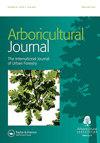Assessing diversity and ecosystem services of trees in educational institutions: A case study of a university campus from the Global South
Q3 Agricultural and Biological Sciences
引用次数: 3
Abstract
ABSTRACT The university campuses in the Global South (low- and middle-income countries of the world) harbour a significant proportion of the trees outside forests which furnish precious ecosystem services. In this study, we conducted field surveys to document the tree flora in the campus of Maharshi Dayanand University, Rohtak (Haryana), India. We documented 35,184 trees belonging to 66 species in 29 families from the campus. Eucalyptus globulus was the most dominant tree species with 13,932 individuals and Fabaceae was the most speciose family. Nearly 60% of tree species in the campus were native. The mean height (m) and circumference at breast height (cm) for the tree flora were 6.51 ± 0.21 and 50.93 ± 1.11, respectively. The overall tree density on the campus was around 140 trees/ha, mean density 2.11 ± 0.87, and the average basal area 0.021 ± 0.0009 m2/tree. The values for Simpson’s, Shannon, Margalef’s and Pielou’s evenness indices were 0.18, 2.51, 6.21 and 0.6 respectively. The campus trees provide valuable ecosystem services with food and medicinal uses, ornamental and shade values being the dominant. Our findings will guide policy on urban environmental sustainability in the educational campuses in India – the second most populous country in the Global South.评估教育机构中树木的多样性和生态系统服务:以南半球大学校园为例
南半球(世界上低收入和中等收入国家)的大学校园里有很大一部分森林以外的树木,这些树木提供了宝贵的生态系统服务。在这项研究中,我们对印度罗塔克(哈里亚纳邦)Maharshi Dayanand大学校园的树木区系进行了实地调查。我们记录了校园内29科66种35,184棵树。蓝桉(Eucalyptus globulus)为优势树种,共有13932株,豆科(Fabaceae)为优势树种。校园内近60%的树种是本地树种。乔木区系平均高(m)为6.51±0.21,胸围(cm)为50.93±1.11。总体树木密度约为140株/ha,平均密度为2.11±0.87,平均基材面积为0.021±0.0009 m2/株。Simpson’s、Shannon、Margalef’s和Pielou’s均匀度指数分别为0.18、2.51、6.21和0.6。校园树木提供了宝贵的生态系统服务,具有食物和药用价值,观赏和遮荫价值占主导地位。我们的研究结果将指导印度教育校园的城市环境可持续性政策——印度是全球南方人口第二多的国家。
本文章由计算机程序翻译,如有差异,请以英文原文为准。
求助全文
约1分钟内获得全文
求助全文
来源期刊

Arboricultural Journal
Agricultural and Biological Sciences-Agronomy and Crop Science
CiteScore
2.40
自引率
0.00%
发文量
28
期刊介绍:
The Arboricultural Journal is published and issued free to members* of the Arboricultural Association. It contains valuable technical, research and scientific information about all aspects of arboriculture.
 求助内容:
求助内容: 应助结果提醒方式:
应助结果提醒方式:


